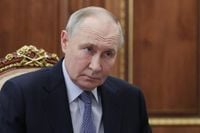In a significant escalation of military preparations, Russian President Vladimir Putin has authorized one of the largest rounds of conscription in years, aiming to enlist 160,000 men aged 18 to 30 into the armed forces. This new phase of conscription, which began on April 1 and will continue until July 15, 2025, marks an increase of 10,000 recruits compared to last year's spring drive and over 15,000 more than three years ago. According to Russian state media outlet TASS, this move is part of a broader strategy to expand Russia's military, which has grown from approximately 1 million personnel three years ago to around 1.5 million today.
This conscription effort comes at a critical juncture in the ongoing conflict in Ukraine, where Moscow has reportedly been relying on North Korean soldiers to bolster its military presence in the Kursk region. As Russian troops continue to engage in sustained attacks in the eastern regions of Ukraine, including the Pokrovsk area of Donetsk, the international community watches closely as the United States attempts to mediate peace talks.
Adding to the complexity of the situation, Kirill Dmitriev, a senior Russian negotiator, is expected to visit Washington this week to meet with Steve Witkoff, a top official in Donald Trump’s administration. This meeting will be the first of its kind since Russia's invasion of Ukraine in 2022, indicating a potential thaw in relations between the two nations. Dmitriev's visit comes amid reports that Trump has expressed frustration with Putin, suggesting that Russia may be “dragging their feet” in negotiations.
Despite ongoing discussions, peace remains elusive. Trump has publicly rejected calls for an immediate ceasefire from Putin, insisting that any ceasefire must be contingent upon the lifting of U.S. sanctions. Following the latest round of talks, the White House announced a moratorium on fighting in the Black Sea, but the Kremlin's response has been less than conciliatory, with Putin setting conditions that complicate the prospect of a peaceful resolution.
In the meantime, the conflict continues to take a toll on civilians. On April 2, 2025, a Russian drone strike in Kharkiv resulted in injuries to several people, including an infant and a seven-year-old boy. This attack is part of a larger pattern of violence, as Russian forces unleashed a barrage of 17 drones over Kharkiv in a single hour, leading to multiple fires but thankfully no casualties. The ongoing assaults underscore the dire humanitarian situation as Ukraine grapples with the consequences of the war.
Ukrainian officials have also reported that they have provided evidence to the United States regarding Russia's violations of a previously agreed-upon energy ceasefire. Ihor Brusylo, the Deputy Head of the Ukrainian President’s Office, stated that the evidence clearly shows Russia's lack of interest in adhering to ceasefire agreements, calling for more decisive action from international partners against what he termed Russia's “insidious policy.”
In a related development, Ukrainian President Volodymyr Zelensky has clarified that a minerals deal currently under negotiation with the U.S. does not include any mention of Ukraine's future NATO membership. Zelensky emphasized that the decision regarding this agreement would be made soon, as the country continues to navigate its complex relationship with Western allies amidst the ongoing conflict.
As the war drags on, the impact on Ukrainian society is profound, particularly as many men are drafted into military service. This has led to a significant shift in gender roles within the country, with women stepping into jobs traditionally held by men, including roles in agriculture and industry. Kateryna Koliadiuk, a 19-year-old agronomy student, shared her experience of learning to drive a tractor, a skill she never imagined she would need as men are increasingly mobilized for combat.
The situation in Ukraine remains precarious, with both sides entrenched in their positions. As the U.S. Senate unites across party lines to propose sanctions on Russia if it fails to engage in genuine negotiations, the international community is left to ponder the ramifications of this ongoing conflict. With half of the Senate backing these measures, it is clear that there is bipartisan concern over Russia's actions and the potential for further escalation.
In summary, as Russia ramps up its military conscription efforts and the conflict in Ukraine continues unabated, the stakes are high for all involved. The upcoming discussions in Washington may provide a glimmer of hope for diplomatic resolution, but with tensions running high and both sides unwilling to compromise, the path to peace remains fraught with challenges.





